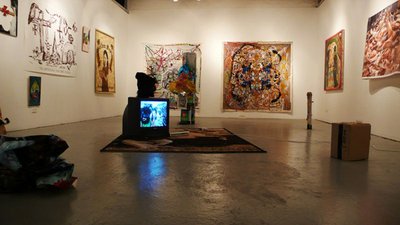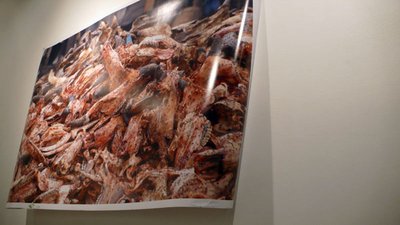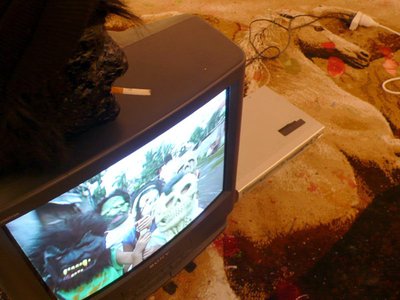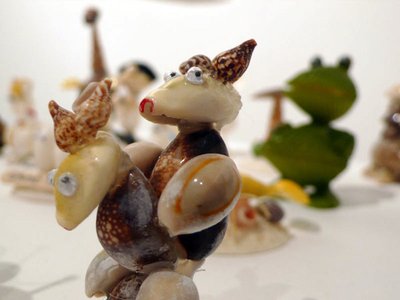God Captured Like Fossilized Dung: New Art from the Third World
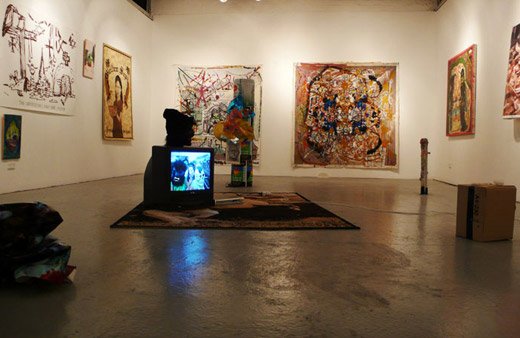
In the show entitled God Captured Like Fossilized Dung: New Art from the Third World , 5 artists from the Philippines and 1 honorary Filipino - David Griggs, who is really Australian but spends a lot of time there, took advantage of the fact that the show coincides with Easter. The Philippines is in fact a devoutly Catholic country where certain bloody rituals, corrupt political mise-en-scene and melodramatic absurdities blanket the emotional character of the people. These above-mentioned qualities are materials ripe for tragi-comic juxtapositions in the works of the artists. That being said the artists in this show refuse to directly reference the Philippines nor God nor dung but of course they are in the details.
Romeo Lee
Romeo personifies the fluxus of artistic activity in Manila. He is a local icon whose persona is a remarkable blend of artist, musician, patron, connoisseur, collector, promoter, pimp, and punk, while remaining oblivious to the tentacular market controls of the artworld. He maintains a Buddhist generosity balanced only by his bohemian rhapsody in punk dressing. He is known for his "ukay-ukay" collections of second hand materials from clothing to sound equipment and various appliances. This is a complex system of objects, mounds and mounds of things, scattered diarrhea-tically and commenting on use and exchange values. Finding art, or the art of the find, is Lee's program of Buddhist interconnectedness and the dismissal of the hold of things on us. This unorthodox anti- commodity stance sets L as a problematic artistic figure in conservative Manila. He is an outsider and an insider at the same time, acting as abstract double-agent. His art is not "formalized" by traditional means, as a product conducive to the hands of the market, but instead serves as a cultural bomb masquerading as product. When he does confront the lure of conventionality through painting, the subject matter of distraught earthly (or subconscious) demons festered with insects in a decaying urban setting like Manila brings forth a denial of the senses not so different from the picture of Dorian Gray, where the facade of beauty is only acceptable as long as you keep the terrible things in control.
Louie Cordero
LC's work is optically spectacular, providing a taste of the apocalypse through the compost of pop capitalism and third world anxiety. The artist speaks through the babble of cartoon language, adopting the graphic style of mass media; but these are not mere pastiches. Rather, like the cartoons that they are, they parallel the conventional cartoons that we typically associate with - those made from the U.S., but in its othering it becomes a caricature of the real thing, the uncanny doppelganger that doesn't know where it begins or ends, and to know that it is a simulacra in the first place. How Filipino. It is only when they deteriorate that they begin to assume the reality of their being, as expired signs continuing the garbage consciousness of consumerism. The hi- definition candy colors course through the indigenous ontological system like artificially sweetened blood opaqued and glossed by the tropical glitter of trash dumps. If ever you wonder where do commercials go when they have outlived its products, well, this is probably it.
Jayson Oliveria
J's work reveals that the authorial death discourse in art isn't constrained to the metropolitan centers of the west. In other words, there is no monopoly when it comes to critical thinking, only perhaps in controlling the distribution channel for goods.
J applies end game strategies for making paintings, and incorporates objects or sculptural elements to betray the uniformity of painting. In other cases, the paintings would have images, but only to serve as props in staging elaborate formal jokes. (This would fit right well amongst a group of artists coming from Cologne in Germany.) Like most works that straddle along the end of art, the works have an internal logic to them that only the artist could explain - if it can be explained. Rather, there is a sense of gamesmanship and perhaps dandyism, where the artist knows all the contradictions within the work while displaying a keen taste for the obsolescence of style. Amongst the works there is a prevalent fin-de-siècle indifference of the signifier corresponding to the questions most artists have in the Philippines, or all Filipino artists for that matter, which is to ask the nature of Filipino art. It poses another important question at the same time, of who will be the audience for this manner of work: a work that is sophisticated in its artistic strategies which is at par with the rest of the world, and yet the constraining issues of ethnic identity chains the progressive content to its stereotypical signifier.
Poi Beltran
Perhaps its difficult to stray from the pull of local social realism, in which a Third World Country like the Philippines produces poverty scenarios like an export good. But the weight in P's work takes away the cancerous bittersweet sentimentality prevalent in most social realist work, and replaces it with a critical mirror, albeit broken, that is best suited for a medium like photography. Her photographs of decaying animal bones within a pile of garbage is perhaps evocative of where the world is heading now.
Manuel Ocampo
Manuel has been around the international art circuit for 20 years now. He has participated in numerous international Biennale's and group shows, most notably Helter Skelter; LA art of the 90's . His art deals with the representation of ideology and the ideology of representation. Swastikas, crosses, skulls, and various political symbols are used to create spontaneous flights of fancy and narratives that opens up new realms for the imagination.
David Griggs
Griggs skims symbols from a range of popular media, layering them one on top of the other without locating them in a particular context. His motifs of fear and danger commonly employed in his work are the dramatic devices of popular culture. There is something unsettling about his works which expertly wavers between being some kind of evil décor and attractive surface, and images that can mean something and live up to the gravity of their subject matter.
- address
-
Inflight Elizabeth Street
237 Elizabeth St, Hobart TAS 7000 - artists
-
Romeo Lee – Artist
Louie Cordero – Artist
Jayson Oliveria – Artist
Poi Beltran – Artist
Manuel Ocampo – Artist
David Griggs – Artist
